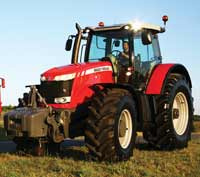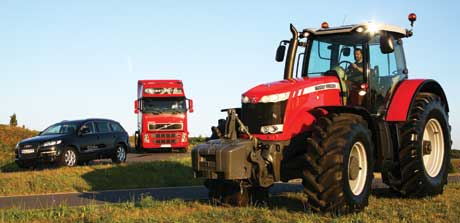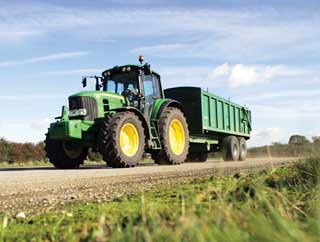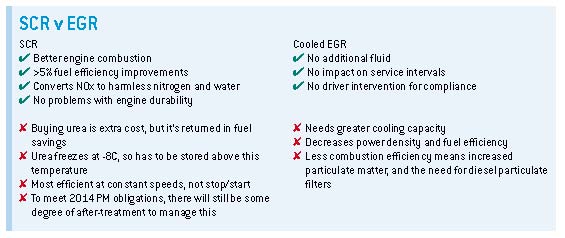SCR vs EGR engine technology

Truck technology helps tractor makers to tackle higher emissions standards. Emily Padfield reports
It’s a question that’s been concentrating the minds of truck and car engine makers for several years and it’s having an increasing influence on how tractor manufacturers are choosing their engines.
How do you meet tightening emission standards for diesel engines without compromising performance and fuel efficiency?
Even if you’re not in the market for a new tractor, sooner or later this will affect you, as even pick-up manufacturers are rumoured to be considering using different methods to meet legislation in the future.
 |
|---|
| MF’s system is identical to that in Volvo trucks and Audi’s Q7 V12 |
What’s the problem?
In 2011, Europe faces the next round of emissions legislation, Stage 3B. Tractors over 175hp will have to adhere to a particulate matter (soot) limit of 0.025g/kWh, 90% lower than that required by Stage II, and a 2g/kWh nitrous oxide (NOx) limit-half the Stage 3 levels.
Come 2014, things get even trickier. Stage 4 introduces a stringent NOx limit of 0.4g/kWh, which is expected to require some degree ofafter-treatment.
There are two main ways to reduce NOx emissions from diesel engines. You either get rid of as much NOx as you can after it’s generated by the engine or you don’t produce it in the first place.
NOx is produced by the high combustion temperatures that occur in dieselengines and the hotter the temperature, the more NOx comes out of the exhaust.
How do you get rid of NOx?
Route 1
One way is Selective Catalytic Reduction, or SCR. This involves injecting urea into the exhaust stream, which provides something else for the oxygen to combine with to form ammonia and carbon dioxide. Thesethen react with the NOx to create nitrogen and water vapour.
Route 2
Or you can try to prevent NOx being formed in the first placeby reducing combustion temperatures.This is where Exhaust Gas Recirculation (EGR) comes in.
By reintroducing cooled exhaust gas back into the combustion chamber, it reduces the oxygen in the process and lowers the overall combustion temperature.
Engine manufacturers have the choice (in broad terms) of these two types of technology to meet targets.
Agco opts for SCR
A company that has firmly nailed its colours to the mast is Agco Sisu Power, which makes engines for fellow Agco brands like MF and Valtra. Last year, it became the first company to introduce SCR into the tractor market with the launch of itsMF 8600 range, closely followed by the Valtra S Series.
“In the truck industry, where they’ve already had to meet these stringent demands for several years, companies like Volvo, Renault,Iveco and Mercedes Benz all use SCR already,” says Campbell Scott, brand manager for Massey Ferguson.
In fact, to meet ultra-strict California emissions standards, many luxury car manufacturers have adopted the technology for their highest-polluting cars, including the Audi Q7 V12 and Mercedes’ Bluetech engine.
ADBLUE IN A MINUTE Where is it available? Find your nearest stockist by clicking on www.findadblue.com. It’s also available from your local Agco dealer. What sizes does it come in? Like other lubricants, in 10-litre containers, 210-litre drums, 1000-litre IBCs and in bulk. How much does it cost? Depending on how much you buy, it costs between 31p and 85p/litre How much do you use? AdBlue is used at a 3% rate to diesel, meaning you need to top up your AdBlue every 2.75 fills of the diesel tank. A 1000-litre tank is enough to treat 33,000 litres of fuel. What if you run out? Tractors fitted with SCR are designed to reduce power output by 50%, allowing you to get home, but not continue with fieldwork. |
The system used in the MF8600 is identical to the set-up used in Volvo’s latest range of trucks. Farm tractors fitted with SCR will have both a diesel tank and a smaller tank for the urea. The trade name for aqueous ammonia isAdBlue, which is made up of about two-thirds ionised water and one-third urea.
“AdBlue is used at roughly 3% of diesel usage, so after 2.75 fills of the diesel tank operators will need to fill the AdBlue tank, too.”
There are already more than 250,000 trucks on Europe’s roads using SCR technology, so it’s a myth that there’s no infrastructure to distribute AdBlue (or Diesel Exhaust Fluid as it’s know in the USA), he adds.
In fact, Agco has entered into a distribution agreement with Brentagg, a specialist chemical distributer for Yara, which markets the chemical under the name Air1.
By using SCR, says Sisu,NOx emissions can be cut by more than 90%, and particulates are considerably reducedin the process.
What does it cost?
“Prices of AdBlue differ depending on the amount you order,” says Mr Scott.”But because engines with SCR systems are set up to run at an optimum air/fuel mix, there’s a considerable fuel saving. Although we’re still waiting for independent tests, a conservative estimate of the fuel saved using the system is 5%.”
Even taking into account the extra cost of AdBlue, this still represents a saving, he says.
At the moment, SCR is the only guaranteed method of meeting both Stage 3B in 2011 and Stage 4 in 2014, Mr Scott adds.
“Those who have gone down the EGR route have effectively bought time to establish another method,” adds Mr Scott.
“As it gets nearer to the 2014 deadline, our combines and other tractor series will adopt the technology. Between now and then, farmers are still going to be looking for engines that are more efficient and legislation isn’t going to be relaxed.”
Perkins and Deere opt for EGR
EGR isn’t new, and has been used by most manufacturers to meet legislation up until now. Whereas previous emissions standards were met by managing the combustion process to create a cleaner burn, using exhaust gases to cool the combustion process works in a similar way.
The process takes a small amount of the exhaust gas, cools it and reintroducesit into the cylinder. Because this gas is high in water vapour, it cools the combustion process and reduces NOx, saysPerkins.
In the past, companies were reluctant to use such technologies because of the danger of soot build-up, but lower-sulphur fuels have solved this.
Perkins says it has decided to use EGR rather than SCR for two main reasons. One is that operators don’t have to buyan extra product, the other is thatextra technology doesn’t haveto bebolted on to the engine.
But the company concedes that it’s likely to consider it as one of the options when it comes to meeting Stage 4 and beyond.
 |
|---|
| Deere and Perkins have opted for EGR. |
For particulate reduction, Perkins has opted for a diesel particulate filter (DPF), which removes 90% of the particulates expelled by the engine. It has also added a diesel oxidation catalyst, which it combines in the same canister. This gathers all the soot and needs to be cleaned regularly through regeneration, basically burning off the soot using a burner in the exhaust stream.
John Deere has opted for the same technology it used for Tier 3 or Stage 3A emissions legislation – high-pressure fuel injection, cooled EGR and variable geometry turbochargers.It’s also adding a diesel particulate filter and a diesel oxidation catalyst as well as crankcase ventilation to meet the stringent NOx obligations, like Perkins.
So will it be a clear division between tractor makers who opt for SCR and those who go for EGR? Probably not, especially when you look at the truck and automotive sector. Here engine companies admit that it’ll be a combination of the two, alongside any other technology which may come along.
Honda, for instance, has already developed a diesel that creates ammonia from diesel fuel, which is then used to convert NOx into nitrogen and water. But there’s a fuel penalty. In short, watch this space.


